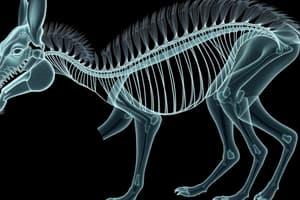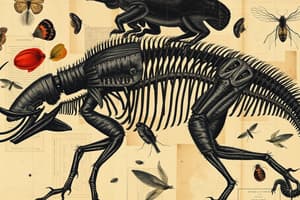Podcast
Questions and Answers
Match the following taxonomic ranks with their definition:
Match the following taxonomic ranks with their definition:
Domain = Highest taxonomic rank, classifying life forms Kingdom = Group of related organisms Genus = Group of closely related species Species = Basic unit of classification, a single type of organism
Match the following major animal groups with their characteristics:
Match the following major animal groups with their characteristics:
Invertebrates = Lack a backbone Vertebrates = Have a backbone Mammals = Endothermic vertebrates that nourish young with milk Reptiles = Cold-blooded vertebrates with scales and typically lay eggs
Match the following examples with their corresponding animal group:
Match the following examples with their corresponding animal group:
Shark = Fish Eagle = Bird Octopus = Mollusk Earthworm = Annelid
Match the following classification criteria with their descriptions:
Match the following classification criteria with their descriptions:
Match the following components of binomial nomenclature with their roles:
Match the following components of binomial nomenclature with their roles:
Flashcards are hidden until you start studying
Study Notes
Animal Classification
-
Definition: The systematic grouping of animals based on shared characteristics.
-
Main Taxonomic Ranks:
- Domain
- Kingdom
- Phylum
- Class
- Order
- Family
- Genus
- Species
-
Major Animal Groups:
- Invertebrates: Lack a backbone.
- Examples:
- Arthropods (insects, spiders, crustaceans)
- Mollusks (snails, clams, octopuses)
- Annelids (earthworms, leeches)
- Cnidarians (jellyfish, corals)
- Examples:
- Vertebrates: Have a backbone.
- Examples:
- Mammals (humans, whales, bats)
- Birds (eagles, sparrows)
- Reptiles (snakes, lizards)
- Amphibians (frogs, salamanders)
- Fish (sharks, salmon)
- Examples:
- Invertebrates: Lack a backbone.
-
Classification Criteria:
- Morphology: Physical structure and form.
- Genetics: DNA and genetic relationships.
- Behavior: Patterns of behavior and adaptation.
- Ecology: Relationships with the environment and other organisms.
-
Binomial Nomenclature:
- Two-part naming system (Genus + Species).
- Example: Homo sapiens for humans.
-
Importance of Classification:
- Helps in identifying and categorizing species.
- Aids in understanding evolutionary relationships.
- Facilitates communication in scientific communities.
Animal Classification
- Systematic grouping of animals based on shared characteristics.
Main Taxonomic Ranks
- Domain: Broadest category grouping living organisms.
- Kingdom: Second highest rank; major categories of life.
- Phylum: Groups animals based on major structural features.
- Class: Further divides phyla into specific groups.
- Order: Breaks down classes into distinct families.
- Family: Groups related genera.
- Genus: Groups species that are closely related.
- Species: Basic unit of classification; a group of individuals that can breed.
Major Animal Groups
-
Invertebrates: Animals without a backbone.
- Includes arthropods (insects, spiders, crustaceans), mollusks (snails, clams, octopuses), annelids (earthworms, leeches), cnidarians (jellyfish, corals).
-
Vertebrates: Animals with a backbone.
- Includes mammals (humans, whales, bats), birds (eagles, sparrows), reptiles (snakes, lizards), amphibians (frogs, salamanders), and fish (sharks, salmon).
Classification Criteria
- Morphology: Based on physical structure and form of animals.
- Genetics: Involves DNA analysis to determine genetic relationships.
- Behavior: Examines patterns of activity and adaptation.
- Ecology: Studies interactions with the environment and other species.
Binomial Nomenclature
- Two-part naming system consists of the genus name and species name.
- Example: Homo sapiens represents humans.
Importance of Classification
- Enables identification and categorization of species.
- Enhances understanding of evolutionary relationships.
- Facilitates effective communication among scientists within the biological community.
Studying That Suits You
Use AI to generate personalized quizzes and flashcards to suit your learning preferences.




